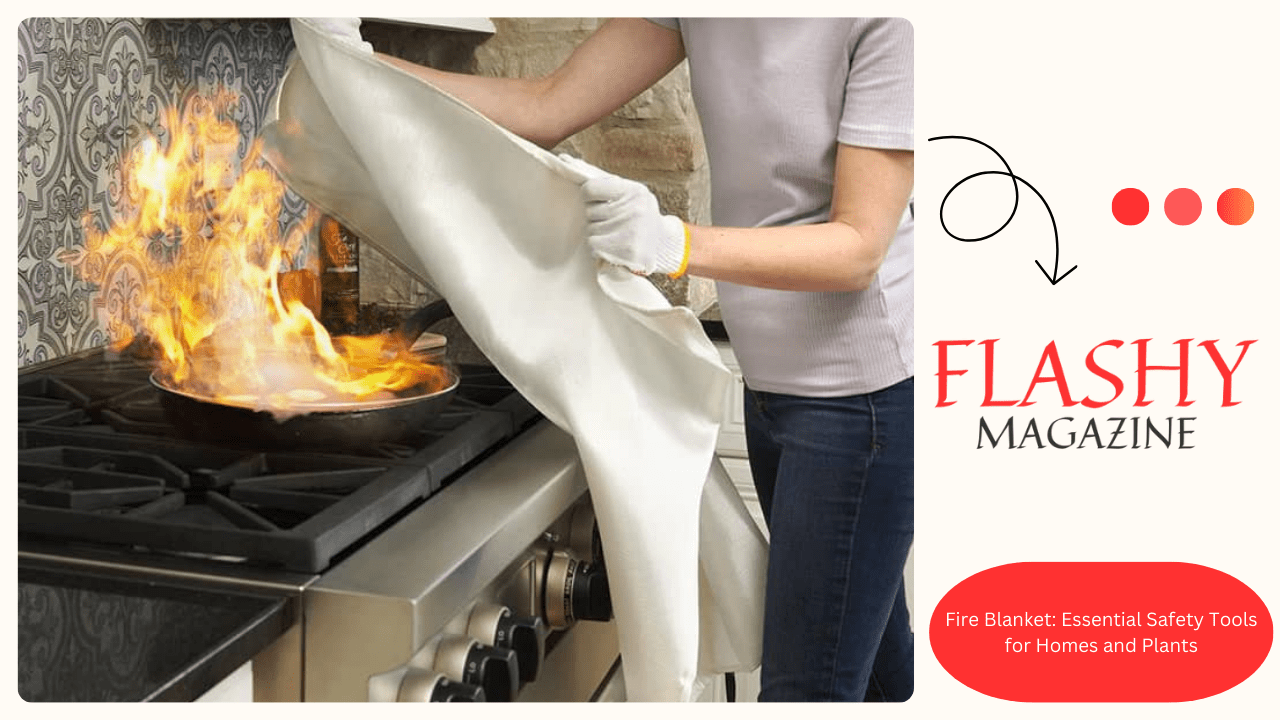Fire blanket are an essential but frequently overlooked tool in fire safety. Designed to smother small fires and help them from spreading, fire blanket can be a lifesaver in the critical first seconds of a fire. They’re easy to use and effective, ideal for putting out cookstove fires, small electrical fires or indeed apparel dears. In this composition, we’ll dive into what fire blanket are, how they work, when to use them, and why every home and plant should have them readily available.
Preface to Fire Blanket
A fire blanket is a simple but important tool that can stop fires before they get out of control. This easy- to- use device has saved innumerous lives by furnishing an immediate system of controlling small fires, especially in kitchens and workplaces where ignitable accoutrements are handled. While fire extinguishers are also critical, fire blanket offer a briskly, low- conservation result that requires minimum training for effective use. Understanding how fire blanket work and where to keep them is essential for anyone looking to ameliorate their fire safety measures.
What’s a Fire Blanket?
A fire blanket is a distance made of fire- resistant material that, when draped over a fire, cuts off the oxygen force and extinguishes the dears. Fire blanket are especially useful for small fires that can be extinguished snappily, similar as cookstove grease fires or small electrical fires. They’re also effective for extinguishing dears on people’s apparel, making them inestimable in both homes and workplaces.
How Fire Blanket Work
The primary purpose of a fire blanket is to extinguish a fire. When a blanket is thrown over the dears, it blocks the force of oxygen that the fire needs to sustain itself. Without oxygen, the fire can not continue to burn and snappily goes out. Fire blanket are designed to be heat resistant and non-flammable, so they wo n’t enkindle or melt indeed when in direct contact with dears. This makes them a safe, simple and largely effective result for managing small fires.
Types of Fire Blanket
There are several types of fire blanket, each acclimatized to a different terrain and fire threat.
Standard Fire Blanket
Standard fire blanket are designed for normal home and office use. They’re ideal for lower garments, cooking oil painting or electric fires.
Fire Blanket for Welders
These fire blanket are designed for artificial use, especially in surroundings where welding and other high temperature tasks are performed. They’re heavier and made of accoutrements that can repel high temperatures, guarding workers and outfit from sparks and molten essence.
Laboratory Fire Blanket
Laboratory fire blanket specialize in dealing with fire hazards in scientific and educational surroundings. They’re frequently stored in wall- mounted holders and are intended for snappily extinguishing fires that may arise during chemical responses or laboratory outfit.
Fire Blanket Accoutrements
Fire blanket are made from accoutrements especially named for their fire resistance and heat absorbing parcels. Laminate utmost standard fire blanket are made of fiberglass, a material that can repel high temperatures without kindling.
Fiberglass
Blanket are featherlight, durable and easy to store, making them ideal for home and office surroundings.
Hair and Other Refractory Accoutrements
Hair fire blanket are frequently used in artificial and welding surroundings. Treated with honey retardant chemicals, these hair robes offer increased resistance to sparks and molten essence, making them suitable for demanding operations.
Why Fire Blanket Are Essential in Fire Safety
Fire blanket are an essential part of fire safety as they offer a quick and effective way to control small fires before they spread. Unlike fire extinguishers, fire blanket bear no conservation and are simple enough for nearly anyone to use. They’re a great first line of defense against fires, especially in areas where fire hazards are more common, similar as kitchens, laboratories and shops.
Fire Blanket vs. Fire Extinguisher
While both fire blanket and fire extinguishers are effective fire control tools, they’ve distinct advantages and limitations.
For and Against Everyone
- Fire Blanket Pros: Easy to use, low conservation, effective on small fires, non-toxic.
- Fire Blanket Cons: Limited to lower fires, not ideal for large dears.
- Fire Extinguisher Pros: Effective for a wider range of fire types, can cover larger areas.
- Fire Extinguisher Cons: Requires conservation, training and can beget a mess when discharged.
For optimal fire safety, it’s recommended to have both a fire blanket and a fire extinguisher handy as they round each other in colorful fire scripts.
Common Use of Fire Blanket
Fire blanket are protean and can be used to extinguish several types of fires:
Kitchen Fires
Fire blanket are ideal for kitchen fires, especially grease fires that are delicate to extinguish with water. Water can beget a grease fire to spread, but a fire blanket can safely smother the dears.
Electrical Fires
Electrical fires are also effectively managed with fire blanket because they do n’t conduct electricity. This makes fire blanket safer to use around appliances and wiring than water.
Clothes Fires
Still, belting them in a fire blanket can snappily extinguish the dears and help farther injury, If a person’s apparel catches fire. This makes fire blanket particularly useful in high- threat surroundings similar as laboratories and artificial installations.
Where to Store a Fire Blanket
For maximum effectiveness, fire blanket should be stored in fluently accessible locales. In the home, it’s stylish to keep in the kitchen or near any place where open dears or high heat sources are present. In workplaces, fire blanket should be placed near implicit fire hazards and located so that workers can reach them snappily in an exigency.
Proper Fire Blanket Use Ways
Knowing how to use a fire blanket effectively can be vital in the event of a fire. Then is a step- by- step companion:
- Pull the Tabs: Most fire blanket come in a bag with two tabs. Pull on these tabs to snappily release the mask.
- Hold the Blanket Rightly: Cover your hands by holding the Blanket in front of you with rolled or folded edges to help becks.
- Approach the Fire with Caution: Keep a safe distance and approach the fire sluggishly.
- Cover the Fire Fully: Precisely place or throw a blanket over the fire to suffocate it.
- Leave the Blanket in Place: Let the blanket sit for a many twinkles to insure the fire is fully extinguished.
- Still, Wrap Them: In the event of a apparel fire, wrap the person in a blanket and help them fall to the ground to roll over and extinguish the dears, If you’re on top of the person.
Fire Blanket Conservation and Modification
While fire blanket bear minimum conservation, regular examination is still essential. Check the blanket for visible signs of wear and tear, gashes or smirching and replace if damaged. Make sure the mask’s packaging or vessel remains complete and accessible at all times.
When Not to Use a Fire Blanket
Fire blanket are not suitable for large fires or fires that have formerly spread significantly. For large fires, it’s better to use a fire extinguisher or void and call the exigency services.
Legal Conditions and Recommendations
Numerous countries and workplaces have specific fire safety regulations that dictate the presence of fire safety outfit, including fire blanket. Compliance with these regulations not only ensures safety, but also helps avoid implicit legal liability.
Fire Blanket in Marketable and Artificial Surroundings
In marketable and artificial settings, fire blanket are frequently needed by law due to the advanced threat of fire. diligence similar as welding, construction and laboratories use special fire blanket that offer redundant protection from sparks, molten essence and ignitable accoutrements .
Norms and Instrument of Fire Blanket
In the US, fire blanket must meet norms set by associations similar as the National Fire Protection Association( NFPA). Internationally, fire blanket can be certified to ISO or EN norms, icing they meet strict safety and quality criteria.
Fire Blanket for First Aid in case of Becks
Fire blanket are not only used to extinguish dears, but can also be used as first aid for becks. Belting the burn in a fire blanket can help stop the burning process and cover the affected area until medical help arrives.
Choosing the Right Fire Blanket for Your Requirements
Fire blanket come in a variety of sizes and accoutrements. Choosing the right one depends on where you plan to use it and the type of fire hazard present. For domestic kitchens, a standard fiberglass fire blanket is generally sufficient, while diligence may bear larger, heavier- duty models.
Conclusion: Fire Blanket as Introductory Fire Fighting Means
Fire blanket are vital tools that can help help small fires from getting life- hanging extremities. Their simplicity, effectiveness and low conservation conditions make them a precious addition to any home, plant or artificial terrain. By having a fire blanket on hand and knowing how to use it, you can insure a safer terrain for yourself and others.
Constantly Asked Questions
- What accoutrements are fire blanket made of?
Utmost fire blanket are made of fiberglass or treated hair, both of which are heat resistant and non-flammable.
- Can a fire blanket replace a fire extinguisher?
Fire blanket complement but do not replace fire extinguishers as they’re suitable for different types of fires and offer different situations of protection.
- How frequently should I check the fire blanket?
At least once a time, check the fire blanket for signs of wear and tear or damage and replace it if necessary.
- Are fire blanket applicable?
Fire blanket are generally intended for single use, especially if they’ve been exposed to dears.
- Is it safe to use a fire blanket on an electric fire?
Yes, fire blanket are safe for electrical fires because they do not conduct electricity.








